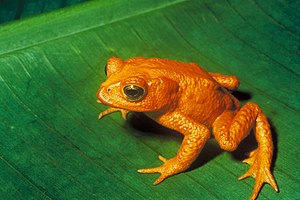Golden toad
| Golden toad | ||||||||||||
|---|---|---|---|---|---|---|---|---|---|---|---|---|

Golden toad ( Bufo periglenes ), male |
||||||||||||
| Systematics | ||||||||||||
|
||||||||||||
| Scientific name | ||||||||||||
| Incilius periglenes | ||||||||||||
| ( Savage , 1967) |
The golden toad ( Incilius periglenes ) was a small Central American frog , which today belongs to the genus Incilius within the toad family (Bufonidae). In earlier classifications, the species was part of the genus Real Toads (Bufo). The species, which was only discovered in the mid-1960s, is now considered extinct .
features
The animals had characteristics typical of toads, such as ear glands , horizontal pupils , warty skin and relatively short hind legs (see also: real toads ). The males reached a maximum body length of 48 millimeters, the females were slightly larger with up to 56 millimeters. There was also a very clear sexual dimorphism in terms of color : while the males were bright yellow-orange all over their bodies, the females had a black-yellow color with scarlet, yellow-edged spots. Young animals, on the other hand, could not yet be externally differentiated according to sex.
Reproduction
The spawning phase of the species was in the period from April to June (heavy rain season). The adult animals went to temporary pools and puddles. The golden toad is classified ecologically as an " explosive spawner ". Such types meet within a short period of the year together in one place (the spawning), then together synchronously the reproduction to perform (see for. Example common toad , frog ). The courtship calls of the male golden toad were very low - it is assumed that visual stimuli, i.e. the bright color, were more important than acoustic signals for pair formation. The males were obviously clearly in the majority: For example, a gender ratio of 8: 1 was found in favor of the male individuals. Since the rutting animals a strong clip reflex had, as is typical of male frogs and toads the mating season, easy "balls" could develop up to ten males who were trying to embrace each other. (This phenomenon can also often be observed in spawning communities of the common toad.) If a male finally succeeded in mating with one of the few females, the latter laid around 200 to 400 eggs (in spawning cords). The tadpoles that developed from it took about five weeks to metamorphose into land animals.
Other way of life and distribution
Little is known about eating habits and activities outside the spawning season. It seems reasonable to assume that golden toads feed on insects and other small invertebrates .
Occurrences were only known from an area only a few square kilometers in the permanent cloud forest in the north of central Costa Rica . The existence of the species there - at an altitude of 2000 to 2100 m - was only proven in the mid-1960s by the zoologist JM Savage, among others. The area has since been protected as the Monteverde Biological Reserve . The German Society for Herpetology and Terrarium Studies (DGHT) even bought a site there from member donations to ensure protection.
Causes of extinction
The IUCN carries out the golden toad on the international Red List now considered extinct ( extinct ) after most recently in 1989 managed a single find of the species. The reasons for the disappearance are not clear. A possible factor is the extremely small distribution area, which increases the probability of extinction of a population, in this case equal to the entire species, due to external influences. The reproductive biology of the golden toad, especially the short spawning time, made the species susceptible. If heavy rain events occurred during this phase, the larvae could be washed out of the spawning waters and drifted onto land. On the other hand, if the precipitation was too low, the waters dried up prematurely. One such year was 1987 when most of the tadpoles failed to metamorphose due to the drought. Some observers assume that global warming due to changes in weather conditions in the region plays a role here. The development of fog , which acts as a moisturizer in the area, is said to have been significantly impaired for some time, as the rise in temperature has shifted the condensation level upwards. Others cite the deforestation of the forest around the reserve as an influencing factor for the disappearance of the golden toad.
In recent years, other species of frogs in the area and in other parts of Central and South America have become rare or have suddenly disappeared completely (compare for example: Stumpy-footed frogs or Ecnomiohyla rabborum ). In addition, the keyword " Amphibian Decline " is already being used to describe the worldwide death of many amphibians, although this is certainly not due to a single cause, but to a combination of various factors. This includes landscape interventions by humans from the impairment and destruction of biotopes , through the use of pesticides , to anthropogenic climate change. But also diseases and parasites - the spread of which is ultimately favored by man-made environmental changes - are held responsible for the global death of amphibians (compare: chytrid fungus , chytridiomycosis ). The golden toad has become a symbol of this development.
literature
- Harding, K. (1993): Conservation and the Case of the Golden Toad. In: British Herpetological Bulletin. 44: 31-34.
- Jacobson, S. (1991): Reproductive Ecology of the Endangered Golden Toad ( Bufo periglenes ). In: Journal of Herpetology. 25: 321-326.
- Pounds, A. (1996): Conservation of the Golden Toad: A Brief History. In: British Herpetological Bulletin. 55: 5-7.
Web links
- Distribution map at iucnredlist.org
- Incilius periglenes in the endangered Red List species the IUCN 2010 Posted by: Alan Pounds, Jay Savage & Federico Bolaños, of 2008.
- Species portrait at Amphibiaweb (Engl.)
- Video on mating and spawning behavior of the golden toad at www.arkive.org
